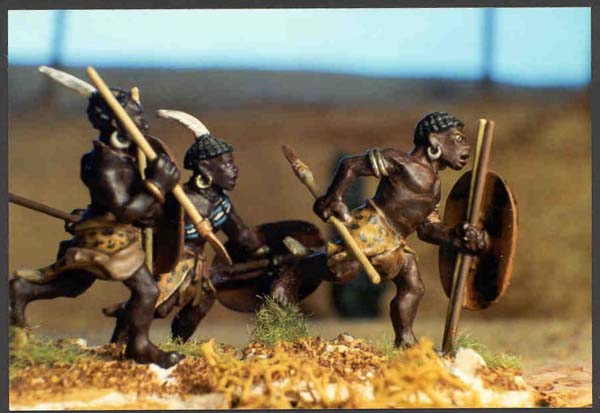The effect I was after was a recreation of that sort of dark skin which some negroes have, which has a fabulous sheen to it, much beloved by photographers. The skin is very dark, but the highlights have a sort of golden quality. I found one method which works. There may be others, of course.
First, do not undercoat with the usual black or white, but use a biscuit colour. Humbrol acrylics are what I use for undercoats. They come in nice big pots which is good for something which one is going to be used as an undercoat, and they dry with a porous surface, which takes later coats of paint particularly well. Acrylics by other manufacturers do not have the same finish. Humbrol "sand" is perfect for undercoating figures.
Next, mix a dark reddish brown. I use a mix of black and Miniature Paints Chestnut brown, which is that rich red-brown colour of a conker which has just come out from its casing. Thin this slightly, and paint it all over the areas of the figure which are bare skin. The sandy-orange undercoat should peep through in the raised areas.
The figures look wrong if you do not add more detail to the hands and feet. They will look as though they are wearing black gloves. Paint the palms of the hands, insides of the fingers, and soles of the feet, with a "flesh" (i.e. European flesh) colour. If there is enough detail on the figure, you can leave breaks between small areas of flesh-coloured paint, so that the joints of the fingers and the like, are separated by dark lines. With a pale flesh colour, paint dots on the fingers and toes to represent the nails. Another touch which looks quite good, is to paint the bottom lip a European flesh colour.
Now paint the rest of the figures: their clothes, equipment and the like. Paint the hair black, and do whatever details you can be bothered with. If you don't paint the eyes, or the teeth if the mouths are open, then these details will be missed far more than they would be on pale-skinned figures.
Now, the varnishing: mix in black paint with your varnish. I use two coats of varnish for my lead figures. The first is yacht varnish which is very strong, but horribly glossy, and the second is "Matt Cote" by Humbrol, which is the only varnish I have found which actually dries properly matt. Unfortunately, they don't put in as much matting agent as once they did, and so now one doesn't get as much useful varnish per pot as once was the case, since to get a proper matt finish, one first has to drain half the clear liquid out of the pot, once the matting agent has settled in the bottom. I wrote to Humbrol to complain, and they denied all this, but I still think that it is true. Anyway, you mix the black paint with the first coat of varnish. I have tried mixing black ink, black acrylic paint, and black enamel paint. The effect of this varnish-paint mix is to darken all the crevices on the figure. The black pigment sinks into these, and the thickness of the varnish holds it there while it dries. With ink, the pigment ends up in the crevices, and no where else, giving a rather cartoon drawing-like effect, with hard black lines. With acrylics, the pigment favours the crevices, but not so definitely, and one gets a rather soft overall shading effect. With the enamels, the effect is most successful, with dark crevices, little darkening of the highlights, and a nice amount of shading in between. This same varnish coat will shade folds in clothing, and knock the goggle-eyed look off the figures, by darkening the whites of the eyes.





